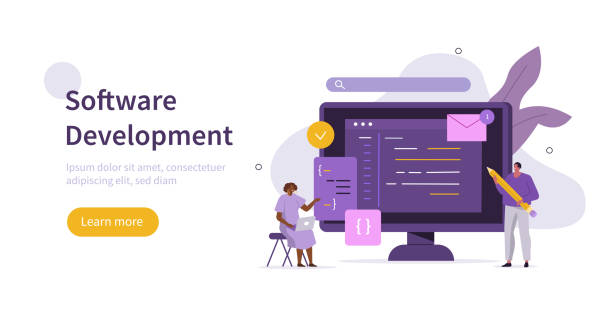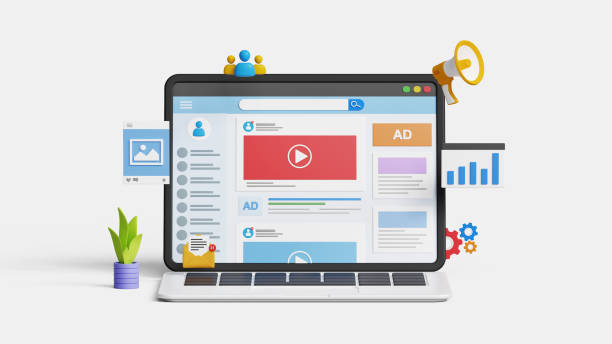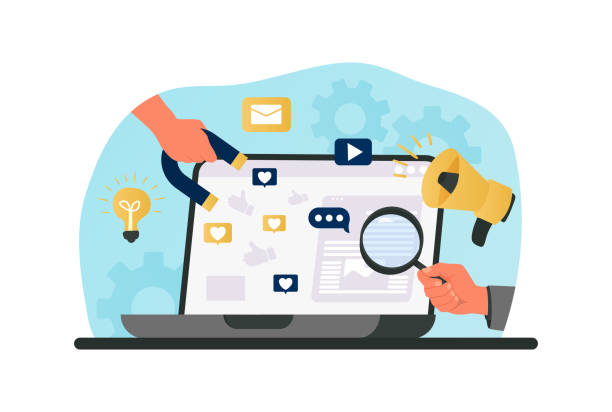The Importance of Secure Website Design in Today’s World

In the current digital age, where an increasing portion of our business and personal activities are moving online, #Web_Security and information protection have become one of the most fundamental concerns.
It’s no longer enough to just have a website; a website that is safe from any intrusion and unauthorized access is required.
Secure website design not only means protecting your users’ sensitive data and your business’s confidential information but also maintaining user trust and your brand’s reputation in the competitive online space.
A vulnerable website can lead to loss of customer information, service disruption, financial damages, and even irreparable harm to your reputation.
In fact, any security breach can incur significant costs, including legal fines, data recovery expenses, and costs to repair damage to the company’s reputation.
Therefore, a proactive approach and investment in a secure infrastructure, from the very beginning of the secure website design process, is considered vital.
This process should start from the initial stages of website planning and architecture and continue continuously through deployment and maintenance.
Understanding that security is an ongoing process, not a one-time event, is essential for every business owner.
Furthermore, educating employees and users about the importance of security and how to identify threats is an integral part of this comprehensive approach.
Ultimately, focusing on Application Security, protecting databases and servers, and implementing standard security protocols form the core pillars of a secure website design.
Do you have an online store but your sales are not as expected? Rasaweb solves your problem forever with professional e-commerce website design!
✅ Significant increase in conversion rates and sales
✅ Exceptional user experience for your customers
⚡ Click to receive free consultation from Rasaweb!
Common Web Security Threats and Countermeasures

In today’s complex digital world, websites are constantly exposed to various #Cyber_Attacks that can infiltrate through #Security_Vulnerability in coding, server configuration, or even user negligence.
Identifying and understanding these threats is the first step towards secure website design and strengthening its defenses.
Among the most common attacks are SQL Injection attacks, where attackers inject malicious code into input forms to gain access to the database.
Cross-Site Scripting (XSS) is another type that allows an attacker to execute malicious scripts in the victim’s browser and steal their information.
DDoS (Distributed Denial of Service) attacks also take a website offline by sending a massive volume of traffic to the server.
Additionally, malware, phishing, Brute Force attacks for passwords, and zero-day vulnerabilities pose continuous challenges for website administrators.
To counter these threats, a comprehensive secure website design approach is crucial.
This approach includes rigorous input validation, strong encryption for sensitive data, implementation of Web Application Firewalls (WAF), regular updates of systems and software, proper access management, and user education.
Furthermore, using Intrusion Detection Systems (IDS) and Intrusion Prevention Systems (IPS) can help identify and block attacks in real-time.
An important part of security solutions is continuous vulnerability assessment and performing Penetration Testing to identify and fix potential weaknesses before they are discovered by attackers.
Paying attention to these points and implementing them at every stage of the website’s lifecycle significantly enhances your digital security and contributes to your business’s sustainability.
Key Principles in Designing and Developing a Secure Website

Secure website design requires adherence to specific principles and standards that must be considered from the very beginning of the development process.
One of these principles is the mandatory use of an #SSL_Certificate or TLS, which #encrypts communication between the user and the server and prevents eavesdropping.
This action not only guarantees data security but also holds high importance for SEO.
Another principle is input validation; meaning all information entered by users (such as forms and queries) must be carefully validated and filtered to prevent injection of malicious code.
Also, using powerful firewalls (WAF) that monitor and filter incoming and outgoing traffic provides an additional layer of defense against web attacks.
Proper management of user sessions and the use of security tokens to prevent CSRF (Cross-Site Request Forgery) attacks are also of high importance.
In addition, secure server configuration and using updated versions of server software (such as Apache, Nginx, PHP, and database) are highly crucial.
File and folder permissions should be limited to the bare minimum, and strong, unique passwords should be used for all user and administrative accounts.
Implementing Two-Factor Authentication (2FA) for the website’s administration section significantly increases security.
Storing user passwords as hashed values using strong algorithms like bcrypt or Argon2 instead of plain text storage is a fundamental principle in protecting user information.
Developers should always use OWASP Top 10 as a comprehensive guide for identifying and mitigating common web vulnerabilities.
Overall, a secure website design is a comprehensive approach that includes secure coding, server configuration, access management, and the use of advanced security tools.
Adherence to these principles at every stage of the website development lifecycle ensures its stability and security.
The table below highlights some key actions for secure website development:
| Security Measure | Description | Importance |
|---|---|---|
| Use of HTTPS (SSL/TLS) | Encrypting communications between browser and server | Essential for data protection and credibility |
| Input Validation | Filtering and sanitizing all user input data | Prevention of code injection attacks (SQLi, XSS) |
| Secure Server Configuration | Limiting access, removing unnecessary services | Reducing server attack surface |
| Proper Password and Authentication Management | Using strong hashing, 2FA, password policies | Protection of user accounts |
| Regular Updates of Software and Libraries | Applying security patches and latest versions | Addressing known vulnerabilities |
The Role of Backend in Website Stability and Security

The backend, or the behind-the-scenes part of a website, is the backbone of any web application and plays a vital role in its stability and secure website design.
This section includes #Server_Security, #Database, and business logic that processes and stores data.
A strong and secure backend ensures proper functionality and protection of sensitive information.
Neglecting backend security can make a website vulnerable to serious attacks such as SQL Injection, Broken Authentication, and Sensitive Data Exposure.
To strengthen backend security, the first step is to use up-to-date and reputable frameworks and programming languages that have built-in security mechanisms.
Furthermore, proper database management is of particular importance; encryption should be used for sensitive data, access should be restricted based on the Principle of Least Privilege, and Prepared Statements should be used to prevent injection attacks.
API security is also an inseparable part of backend security, as these interfaces are often gateways to accessing website data and functionality.
Implementing strong authentication, Rate Limiting, and using security tokens for API requests are essential.
Additionally, secure server configurations include regular updates of the operating system and server software, disabling unnecessary ports and services, and using network firewalls and Web Application Firewalls (WAF).
Continuous monitoring of server logs to identify suspicious activities and implementing IDS/IPS systems also helps detect and prevent attacks.
Finally, performing periodic penetration tests and vulnerability assessments for the backend reveals hidden weaknesses and allows developers to address them before they are exploited by attackers.
Full attention to these aspects strengthens website security from its core and ensures its long-term stability.
Are your e-commerce website visitors leaving before purchasing? Don’t worry anymore! With Rasaweb’s professional e-commerce website design services, solve the problem of not converting visitors into customers forever!
✅ Significant increase in conversion rate and sales
✅ Exceptional and engaging user experience
⚡ Contact us now for a free consultation!
The Importance of User-Side Security and Awareness

Despite the major focus on server-side and backend security, #Browser_Security and user-side security also play a vital role in completing the secure website design puzzle.
Many cyberattacks target users as an entry point, so educating and raising their awareness is of high importance.
Attacks such as #Phishing and social engineering deceive users into disclosing their sensitive information, while #XSS attacks can allow attackers to execute malicious scripts in the user’s browser and steal cookies, session information, or other data.
To protect against these threats, websites should use Content Security Policy (CSP) to limit the resources that can be loaded on the page and reduce the risk of XSS attacks.
Additionally, developers should avoid using old and vulnerable JavaScript libraries and frameworks and always keep them updated.
Ensuring that no sensitive code or API keys are exposed on the client-side is crucial.
For users, training on how to identify phishing emails, the importance of using strong and unique passwords, and enabling two-factor authentication (2FA) for all online accounts can significantly protect them against attacks.
Encouraging users to use updated and secure browsers, as well as reputable antivirus software, is also an important part of the user-side security strategy.
A secure website design should not only focus on coding and infrastructure but also include awareness programs and guidance for users to turn them into an active layer of defense.
Ultimately, shared responsibility between developers and users is a way to create a safer online ecosystem and significantly contributes to maintaining digital security.
Continuous Updates and Periodic Security Audits

Secure website design is not a one-time process; it requires continuous attention and maintenance.
The cybersecurity threat environment is constantly evolving, and hackers refine their penetration methods by discovering new vulnerabilities.
Therefore, #System_Updates for software, plugins, and website themes are crucial.
Developers of software and Content Management Systems (CMS) like WordPress, Joomla, and Drupal regularly release #Security_Patch to fix discovered vulnerabilities.
Ignoring these updates can leave your website highly vulnerable to known attacks.
In addition to updates, performing #Periodic_Security_Audits and #Vulnerability_Scanning is also essential to identify potential weaknesses before they are discovered by attackers.
These audits can include source code review, Penetration Testing, and server configuration assessment.
Penetration testing is carried out by security experts simulating real attacks to identify and fix weaknesses.
Also, using automated vulnerability scanning tools can continuously check the website for security issues and provide detailed reports.
Implementing a regular maintenance program that includes reviewing security logs, monitoring network traffic, and checking backups helps maintain website security over time.
These continuous actions ensure that your website is protected against new threats and its security level is always optimal, which is an important part of a comprehensive secure website design strategy.
Security Incident Management and Data Recovery

Despite all preventive measures in secure website design, the probability of #Security_Incidents never reaches zero.
Therefore, having a comprehensive and effective #Incident_Response_Plan is crucial.
This plan should include specific steps for identification, containment, eradication, recovery, and learning from incidents.
Rapid identification of a security breach is the first step.
This can occur through monitoring systems, user reports, or Intrusion Detection Systems (IDS).
Upon identification, immediate actions must be taken to contain the attack and prevent its spread to other sections.
These actions may include disconnecting the website from the network, isolating infected servers, or blocking attacker IP addresses.
The next step is root cause analysis; that is, identifying the main cause of the intrusion and the vulnerability that was exploited.
This step is very important to prevent recurrence of the incident in the future.
After root cause analysis and vulnerability patching, the #Data_Recovery phase and restoring the website to normal operation begin.
Here, the role of #Regular_Backups and reliable backups is vital.
Having up-to-date and secure backup copies of the database and website files allows for restoration to a pre-incident state.
A Disaster Recovery Plan, which includes detailed steps for restoring systems and data after a major incident, should be regularly tested and updated.
Finally, after each incident, the team should perform a Post-Mortem Analysis to learn from the experiences gained and strengthen their defense mechanisms.
This continuous cycle of prevention, detection, response, and learning helps organizations increase their resilience against cyber threats and ensures that their efforts for website security are effective.
The table below shows the key stages of security incident response:
| Stage | Description | Key Actions |
|---|---|---|
| Preparation | Creating necessary plans, policies, and tools before an incident | Developing response plan, regular backups, team training |
| Identification | Detecting the occurrence of a security event | Monitoring logs, using IDS, user reporting |
| Containment | Preventing damage spread and controlling the incident | Isolating systems, disconnecting from network, IP blocking |
| Eradication and Removal | Discovering the root cause of intrusion and complete removal | Forensic analysis, malware removal, vulnerability patching |
| Recovery | Restoring systems and services to normal operation | Using backups, system rebuilding, performance testing |
| Lessons Learned (Post-Mortem) | Reviewing the incident to improve future security processes | Comprehensive analysis, plan updates, new training |
Legal and Ethical Aspects of Website Security

Secure website design is not merely a technical matter but has important #Legal and #Ethical dimensions that every business must address.
In many countries, stringent laws exist for #Privacy and user data protection, such as GDPR (General Data Protection Regulation) in Europe and CCPA in California.
Non-compliance with these laws can lead to severe financial penalties and serious damage to a company’s reputation.
Therefore, when collecting, processing, and storing users’ personal information, full transparency must be ensured, and their explicit consent must be obtained.
Privacy policies should be clearly stated on the website and easily accessible to users.
From an ethical perspective, a responsible website should demonstrate its commitment to protecting user data and respecting their privacy.
This includes implementing strong security mechanisms to prevent data breaches and providing immediate and transparent notification in the event of any security incident.
Concealing or neglecting security breaches can not only have legal consequences but also irrevocably harm public trust.
Websites should avoid collecting excessive unnecessary information and only collect data essential for service provision.
Furthermore, users should be given sufficient control over their data, including the right to access, rectify, and delete information.
Adhering to information security standards such as ISO 27001 and regularly performing security risk assessments help businesses fulfill their legal and ethical obligations in digital security effectively.
Ultimately, a responsible approach to security and privacy is not just a legal requirement but an opportunity to strengthen customer relationships and build a trustworthy brand in the online space.
Are you dissatisfied with low sales from your e-commerce site?
Rasaweb is your solution for a professional and high-selling e-commerce website.
✅ Significant increase in sales and revenue
✅ Easy and enjoyable shopping experience for customers
⚡ Get a free consultation from Rasaweb now!
The Future of Secure Website Design and New Challenges

The future of secure website design is continuously evolving and brings new challenges with technological advancements and the emergence of new threats.
With the increasing use of #Artificial_Intelligence and Machine Learning, hackers are also using these technologies to develop more sophisticated and automated attacks.
Conversely, these technologies also offer powerful tools for defense, such as AI-powered intrusion detection systems that can identify anomalous patterns more quickly.
Quantum Security and Post-Quantum Cryptography have also become a hot topic, as future quantum computers may be able to break current encryption algorithms.
Therefore, research and development in this field are essential for long-term data protection.
#Blockchain technology also holds great potential for enhancing website security, especially in authentication and decentralized data storage.
However, its widespread implementation still faces challenges.
Another significant challenge is the increasing complexity of the web ecosystem with the growth of the Internet of Things (IoT) and the connection of more devices to the network, which creates new points of vulnerability for intrusion.
Web 3.0 and the concept of a decentralized internet are also emerging, which could offer new security models but will also face unique security challenges themselves.
To address these challenges, international cooperation, knowledge exchange, and investment in education and research in cybersecurity are paramount.
Organizations should implement a “Security by Design” approach in all stages of developing their products and services.
This approach means considering security considerations from the very beginning of system design and architecture, rather than adding security as an additional layer at the end of the process.
Adopting this approach and being aware of future trends in website security helps businesses remain stable and secure in the complex and ever-changing digital world.
Conclusion and Final Recommendations for a Sustainable Website

In this article, we explored the importance of secure website design, common threats, key security principles, the role of backend and frontend, as well as legal aspects and the future of this field.
It is clear that #Cybersecurity is no longer an option, but a #Vital_Necessity for every business and organization operating online.
A #Comprehensive_Approach to website security means considering it at all stages of the software development lifecycle, from initial design to maintenance and incident response.
Investing in team training, using up-to-date technologies, and conducting regular security audits are key pillars of this approach.
To ensure your website security and protect valuable data, consider the following final recommendations:
- Encrypt Communications: Always use HTTPS (SSL/TLS) for all your website communications.
- Validate Inputs: Carefully validate and filter all user inputs to prevent injection attacks.
- Regular Updates: Keep the server operating system, Content Management System (CMS), plugins, and any other software used on the website constantly updated.
- Strong Password Management: Use complex and unique passwords and enable two-factor authentication (2FA) for administrative panels.
- Secure Server Configuration: Disable unnecessary services, limit access, and configure appropriate firewalls.
- Regular Backups: Regularly back up your website data and database in a secure location.
- Incident Response Plan: Have a documented plan for dealing with security incidents and practice it regularly.
- Educate Users: Inform your internal and external users about cybersecurity best practices and threat identification.
Adherence to these principles and a #Continuous_Commitment_to_Security will not only protect your website from threats but also build customer trust and help you confidently step into the #Digital_Future.
Securing the site is a smart investment for the long-term stability and success of your business.
Frequently Asked Questions
| Row | Question | Answer |
|---|---|---|
| 1 | What is secure website design? | Secure website design is a process in which websites are built with security measures in mind from the initial development stages to protect against cyberattacks, unauthorized access, and data loss. |
| 2 | Why is secure website design important? | Website security is crucial for maintaining user trust, protecting sensitive information (personal and financial), preventing damage to brand reputation, and complying with privacy and security regulations (such as GDPR). Security breaches can lead to financial and legal damages. |
| 3 | What are the most common cyberattacks a website faces? | Some of the most common attacks include SQL Injection, Cross-Site Scripting (XSS), Distributed Denial of Service (DDoS), Brute Force, and credential stuffing attacks. |
| 4 | What is SQL Injection and how to prevent it? | SQL Injection is a type of attack where the attacker attempts to manipulate the database or extract information by injecting malicious SQL code into site inputs. To prevent it, Prepared Statements/Parameterized Queries, ORM (Object-Relational Mapping), and rigorous input validation should be used. |
| 5 | What is Cross-Site Scripting (XSS)? | XSS is a type of attack where an attacker injects malicious scripts (usually JavaScript) into web pages that are executed by other users’ browsers. This can lead to the theft of cookies, session information, or alteration of the website’s appearance. |
| 6 | How can Brute Force attacks on login pages be prevented? | To prevent Brute Force attacks, CAPTCHA, limiting the number of failed login attempts (Account Lockout), Two-Factor Authentication (2FA), and using complex and long passwords should be employed. |
| 7 | What is the role of HTTPS in website security? | HTTPS encrypts communication between the user’s browser and the website server using SSL/TLS. This prevents eavesdropping, tampering, or spoofing of information during transmission and increases user trust. |
| 8 | What is the importance of Input Validation in security? | Input validation is the process of checking and sanitizing data entered by the user. This prevents code injection attacks, XSS, SQL Injection, and other vulnerabilities, ensuring that the data conforms to the expected format. |
| 9 | Why is regular updating of website systems and software essential? | Regularly updating the operating system, CMS (like WordPress), plugins, themes, and libraries used fixes known security vulnerabilities. Hackers often exploit weaknesses in outdated software for intrusion. |
| 10 | What role do regular backups play in secure website design? | Regular and tested backups of website information (database and files) are a vital layer of defense against data loss due to cyberattacks, human error, or hardware failure. This enables rapid website recovery in the event of a disaster. |
And other services of Rasaweb Advertising Agency in the field of advertising
Smart SEO: Revolutionize online growth with Google Ads management.
Smart Conversion Rate Optimization: An effective tool for digital branding through custom programming.
Smart Website Development: A professional solution for customer acquisition with a focus on using real data.
Smart Sales Automation: A professional solution for online growth with a focus on precise audience targeting.
Smart Digital Advertising: An innovative service for increasing customer attraction through attractive UI/UX design.
And over hundreds of other services in the field of internet advertising, advertising consultation, and organizational solutions
Internet Advertising | Advertising Strategy | Advertorial
Resources
The Importance of Security in Website DesignHow to Secure Your Online Business?Website Security ChecklistSSL Certificate and Its Role in Site Security
? Are you ready to transform your business in the digital world? Rasaweb Digital Marketing Agency, with expertise in professional website design, SEO, and content marketing, offers a comprehensive solution for your growth and visibility. With us, discover your brand’s true potential.
📍 Tehran, Mirdamad Street, next to Central Bank, Southern Kazeroun Alley, Ramin Alley, No. 6


